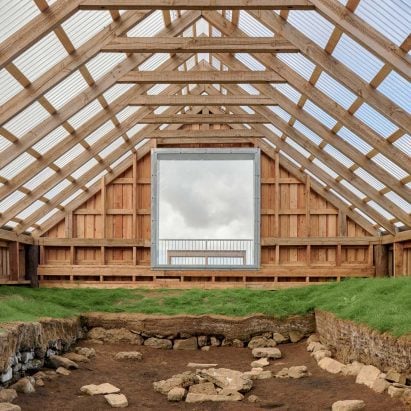A shelter protecting Viking ruins and playful designs for entertaining dinner guests were among the highlights of this year’s DesignMarch festival in Reykjavík.
The 17th edition of the annual design festival took place over five days last week, with a host of exhibitions and installations located in venues across the Icelandic capital.
Responding to this year’s theme, Source, some of the designers’ works explored using Iceland’s natural resources, including lava, algae, wool and clay.
Read on for eight exhibition highlights from this year’s DesignMarch:
The (Re)interpretation of Stöng
Icelandic architecture studio Sp(r)int Studio worked with the Cultural Heritage Agency of Iceland to host an exhibition on the transformation of a Viking-era settlement named Stöng.
The exhibition revealed Sp(r)int Studio’s intervention on the archaeological site, which included updating an existing timber shelter from the 1950s and adding a polycarbonate roof.
Sustainability was a driving factor in the studio’s design, aiming to reuse as much of the existing structure as possible and celebrating it with the transparent roof panels.
Children and City Planning by Þykjó
Local design studio Þykjó overhauled the Reykjavík Art Museum with colourful and playful furniture for its exhibition, Children and City Planning.
The studio aimed to create an immersive environment for children with its pieces, which included shell-shaped shelters for kids to retreat into, nest-like lounge seats and boxes with viewing holes designed to mimic how different animals see the world.
Smiðjumúr by Sei Studio and Antonía Bergþórsdóttir
Smiðjumúr is a series of tiles made from local glacial clay, designed by architecture firm Sei Studio and ceramicist Antonía Bergþórsdóttir to celebrate the beauty of the rugged Icelandic landscape.
According to Sei Studio and Bergþórsdóttir, 95 per cent of construction materials in Iceland are imported, resulting in a high carbon footprint. The pair wanted to tackle this by utilising local clay for surface tiles, which vary in colour due to ash content.
“A lot of people believe that Icelandic clay is not good enough,” Bergþórsdóttir told Dezeen. “We are now reconnecting with the material and looking at this really well-hidden secret.”
Photosynthesis by Bryndís Bolladóttir
Sound-absorbing wall panels, wall-mounted domes and hanging cylinders made up the Photosynthesis exhibition, which was designed by Icelandic artist and textile designer Bryndís Bolladóttir to “please all the senses”.
The acoustic designs featured textural, mottled patterns made from recycled and local wool fibres in calming tones of white, grey, blue and green.
Hæ/Hi – Objects for Hosting
Hæ/Hi returned to DesignMarch for the fourth edition of the collaborative exhibition, bringing together design studios based in Iceland and the city of Seattle, which is home to the largest Icelandic population in the US.
This year’s iteration was titled Objects for Hosting and featured playful kitchen items for entertaining guests, including steel salt and pepper shakers informed by the Bauhaus movement, designed by Icelandic design studio Huggetta, and a candle holder with glass globes that diffuse light by Seattle-based designer John Hogan.
Also on display was a plant pot topped with a light and lampshade, designed by Jón Helgi Hólmgeirsson as a compact greenhouse for herbs, a doodle-like tablecloth by Weird Pickle Creative and ceramic bottle stoppers in the shape of hors d’oeuvres by Hanna Dis Whitehead.
Lavaforming by Arnhildur Pálmadóttir
For DesignMarch’s DesignTalks conference, which was livestreamed by Dezeen, Icelandic architect and founder of S.ap Architects, Arnhildur Pálmadóttir, spoke about using lava as a building material.
Iceland’s Reykjanes peninsula experienced its latest volcanic eruption last week on 1 April, becoming the 11th since 2021. Pálmadóttir’s research into hot lava as an alternative to concrete began in 2018, and she is currently developing it for the Icelandic Pavilion at the upcoming Venice Architecture Biennale.
“We were investigating what resources we have in Iceland, because we don’t have many big forests and trees for construction,” Pálmadóttir told Dezeen. “Then this volcanic activity started, so we thought maybe this could be something we can use.”
Re-Mapping the Arctic
Design and New Environments master’s students at the Iceland University of the Arts held an exhibition titled Re-Mapping the Arctic, aiming to propose creative design solutions for inhabiting the Nordic Polar and Circumpolar regions.
The exhibition, which took place at Alvar Aalto’s Nordic House, included an Arctic beekeeping chamber wrapped in aluminium bubble wrap by Max Greiner, an illustration that envisions how puffins might evolve in the future by Sun Mengyuan and an exploration into the untapped potential of Iceland’s shellfish resources by Katia Taylor and Anna Wallenius.
Natalia Grociak and Eerika Minkkinen displayed a board game highlighting the ethical issues behind Arctic mining, while Janek Beau and Greiner hosted a street food stand distributing sticks of Blue Whiting, an Icelandic fish typically used for animal feed.
Ocean Paints by Dýpi
At Reykjavík’s Ásmundarsalur gallery, Icelandic startup Dýpi showcased its collection of plastic-free paints made from calcareous algae, which is sourced from the Arnarfjörður fjord in northern Iceland.
Dýpi created its paints with the aim of providing a low-carbon alternative to traditional paints, which commonly contain binders made from polymer.
DesignMarch took place from 2 to 6 April 2025 in Reykjavík, Iceland. See Dezeen Events Guide for an up-to-date list of architecture and design events taking place around the world.
The post Eight highlights from DesignMarch in Iceland appeared first on Dezeen.
